The growth trajectory of online shopping was impressive before the COVID-19 pandemic but over the last several months, shopping behaviors have significantly changed. In March 2020, over 42% of the U.S. population bought groceries online, nearly doubling since 2018. People are shopping online now more than ever for both for their business and personal needs. Regardless of your industry, it is critical to have your website’s product pages optimized for search and conversion.
At 3 Aspens Media, we work with multiple ecommerce platforms on various content management systems (CMS). While problems may vary from platform to platform, here is a list of the most common SEO mistakes we see on product pages.
Not Securing Your Website with HTTPS
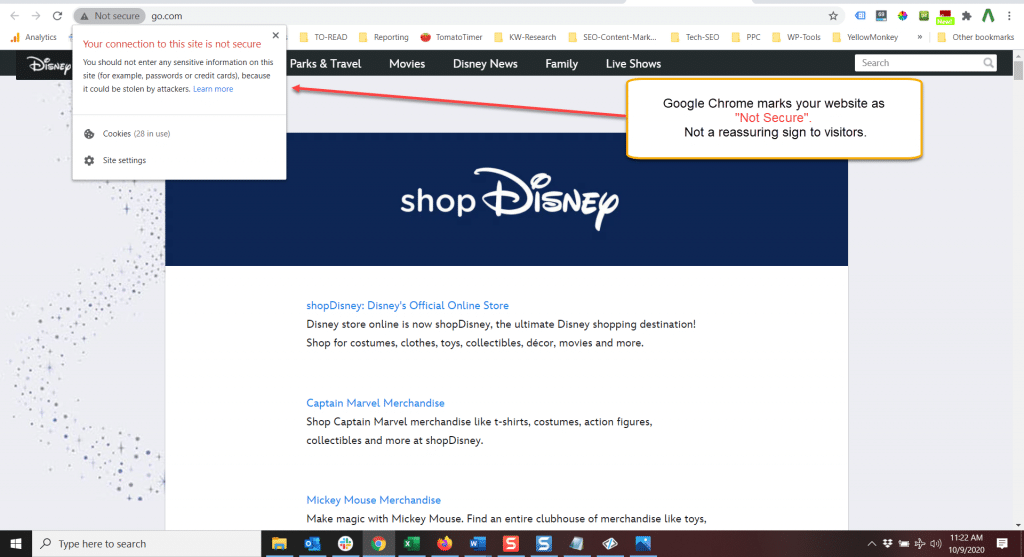
Several years ago, Google stated that security on your website is so critical that they now consider security a search ranking factor. All websites must indicate to their visitors that their online experience is safe – and those with ecommerce functionality most of all. You never want your website to display an unsafe alert to a potential customer. Make sure your CMS vendor or website developer stays on top of your website’s security status. Security certificates can expire without a site owner being aware or your site might have a configuration issues causing errors.
Read more about how to secure your website.
Neglecting to Do Keyword Research
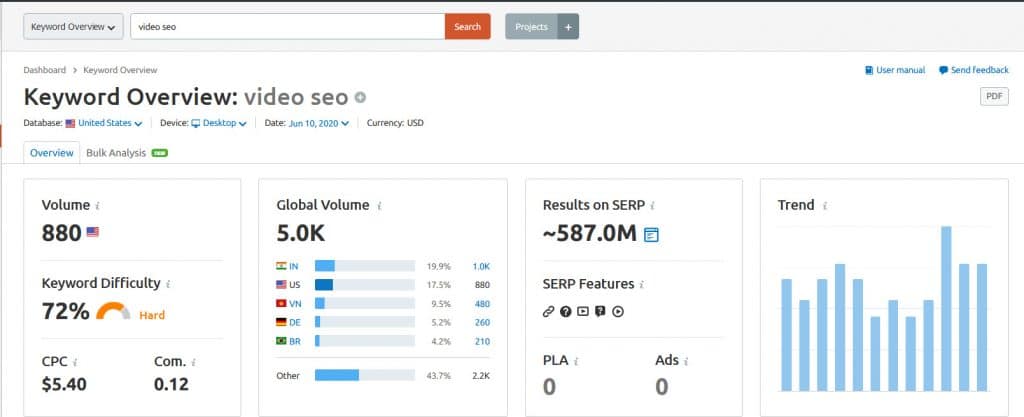
Keyword research should be is a foundational aspect of your product page optimization planning. Each product page on your site should have an assigned target keyword/phrase as well as a short list of variants to use in your product description. We often create product titles and descriptions based on internal company discussions or historical patterns. You need to know what phrases your customers are using to describe your products. Don’t go overboard with keyword stuffing but do have a short list of synonyms in your product spreadsheet.
How Should You Prioritize Your Keyword Research?
For sites with thousands of products, prioritize your SEO efforts by products that generate the most revenue and products that get the highest number of pageviews.
Make sure your keyword research also includes analyzing your top competitors’ product pages. What keywords do those pages rank for? Should you also be targeting those keyword phrases in your on-page tactics? Any of the major keyword tools like SEMRush, Ahrefs or Moz give you amazing insight into your competitors’ product pages.
Not Adding Structured Data to Your Product Pages
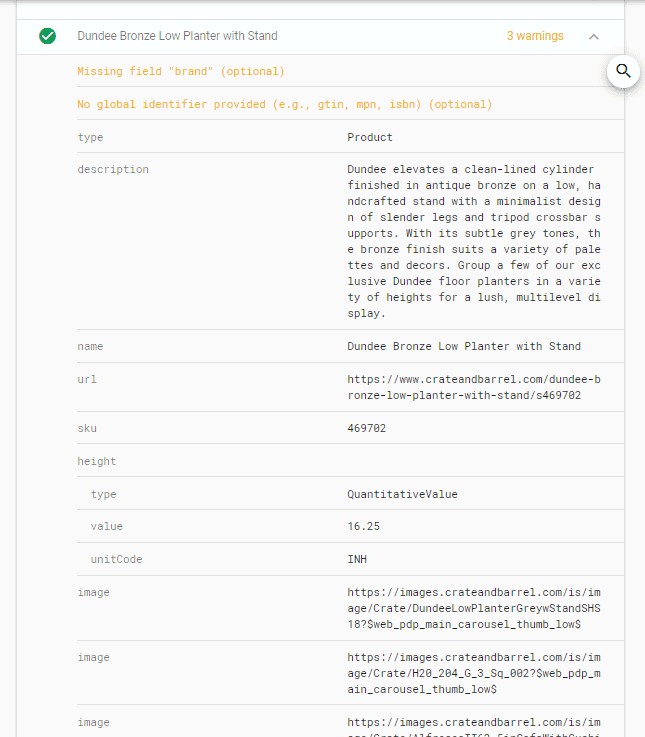
Structured data is a set of descriptors or vocabulary that you add to the HTML code behind the scenes of your website. There are many types of schema but for product page SEO, we’re specifically referring to the product type schema.
JSON-LD is a linked data format recommended by Google for creating your structured data.
What are the benefits of structured data?
Structured data concisely and neatly describes your product information. The benefit of having this type of code on your product pages is that is makes it easy for Google (and other search engines) to understand the page.
Google extracts this data to use in populating rich snippets – which are often found at the very top of a search engine results page.
This is a screenshot of a search results page displaying a “rich snippet” – content that appears often at the top of a search page.
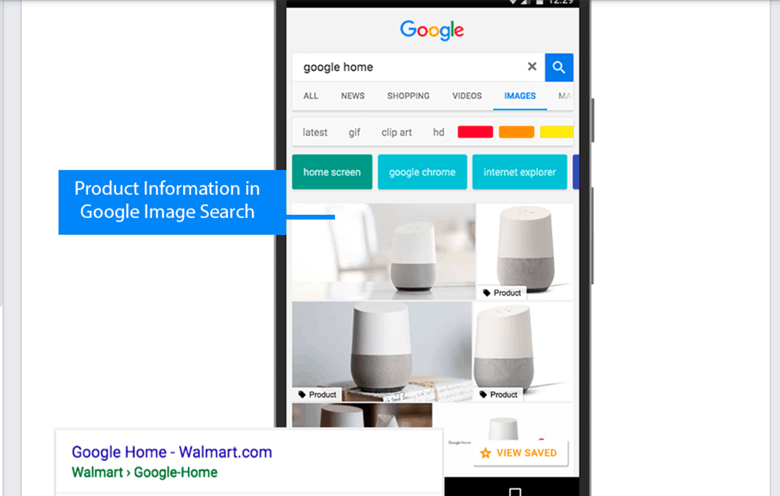
Studies have shown that the click through rate (CTR) on these type of rich snippets are often 30% higher than the good old blue links that appear below them in search. Google’s search results layout has changed dramatically over the years. And while having structured data on your product pages doesn’t guarantee your pages will rank at the top of a search page, it will give you a fighting chance to be there.
Forgetting On-page Optimization
If you have skipped doing keyword research, then you most likely have not optimized the critical details of your page. Those include:
Meta Title and Meta Description Tags
A well-optimized product page (or any page) should include your target keyword/phrase in your page’s meta title and meta description. Those two aspects are what a customer will first see on a search results page. Make sure you describe the product accurately and include benefits. Explain why the customer should buy your product in the meta description.

Most ecommerce platforms use templates to populate the data for meta title, meta description and h tags. Review those templates and make sure they are search friendly. Many vendors overlook the critical nature of these metadata fields and simply pull programmatically from your catalog.
You should be able to work with your developers to programmatically modify the template at scale. For example, perhaps you want the meta description to pull from your item’s extended description rather than a short description. There are efficient ways to alter a built-in template if you’re not satisfied with the out-of-the-box solution.
H Tags
For product pages, most often your H1 – or your primary title on a website – will also be the product name. This is fine. Your H2s – usually subheads – should ideally correspond to any sections you have within your product description.
Again, most ecommerce platforms have templates programmatically populating these. Review your product page template’s header tag structure and make sure they are following the recommendations above.
An easy tool to review any page’s critical on-page elements is the free MozBar. Below is an example of a page with the MozBar highlighting SEO details.
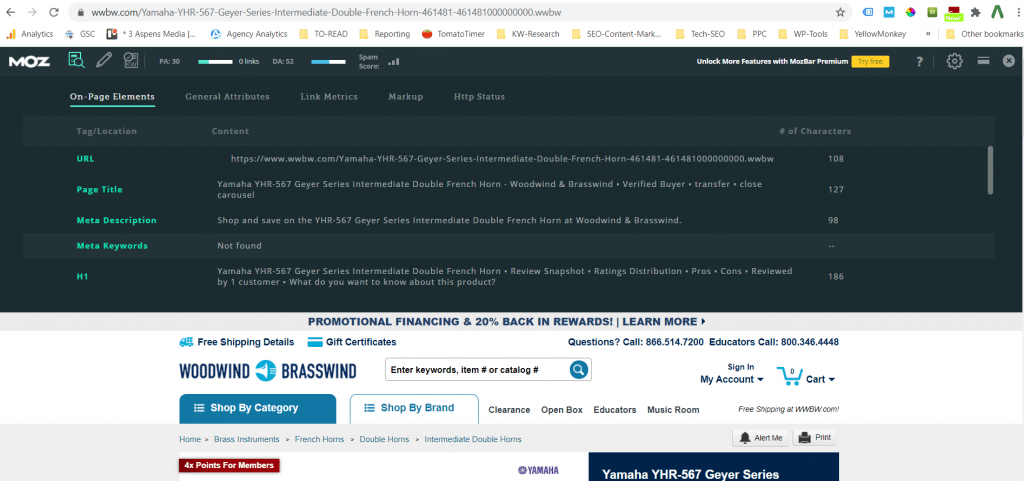
URLs
In the past, the ‘out-of-the-box’ URL structure rendered by many ecommerce platforms looked something like this:
https://www.mystore.com/default.aspx?page=item+detail&itemcode=ABCD-1234
Does that URL tell you anything about the product? Is it easy to glean any meaning from that URL? Nope.
A search-optimized URL will include the product name in a reader-friendly fashion, such as: https://www.grainger.com/product/3M-Adhesive-Applicator-Gun-2KVB3
Work with your ecommerce developers to programmatically produce more search and user-friendly URLs, if they are not created this way by default.
Writing Poor Product Descriptions
The copy in your product description should simply answer these questions:
- What is it?
- What are the benefits?
- Why should I buy this product over others?
Your copy should include bulleted lists if there are lots of features to review. Make sure to include similar terms to your target keywords/phrases. And of course, make sure you include shipping information.
Not Including Images and Videos (or Using Low-Quality Ones)
No matter what the product is, a customer wants to see a visual representation. Not including an image on your product page makes a visitor possibly wonder about the quality of your products since you do not have a high-quality, informative website. Pages with images and videos generally help increase the time a user will spend on a page. Pages with longer dwell times correlate with higher search rankings.
Make sure you add alt-tags (descriptions) to your product images. If your ecommerce platforms does not do this by default, make sure to discuss a plan with your vendor to add this as a task to your roadmap.
Lacking Product Reviews

Amazon has pushed product reviews to be an expected component of your product page layout. Social proof is more powerful than the most gorgeously constructed product description. Many tools on the market help you solicit, aggregate and populate reviews on your website. BazaarVoice is one of the leaders in this space.
Missing Technical SEO Opportunities
Larger ecommerce sites have additional challenges to tackle – one of the top being duplicate content created by faceted navigation. Pages can often be tagged under various filters and many ecommerce platforms then create duplicate versions of those pages – just the URL is different.
The recommended solution for this is setting a canonical URL. You do not want Google and other search engines wasting time crawling 10 different versions of the same page and maybe not getting to other key pages on your site.
We hope these 8 tips are useful to you and your ecommerce team. Please reach out to us with any questions or to do an SEO Audit of your website.



